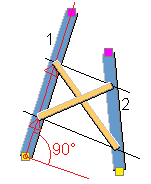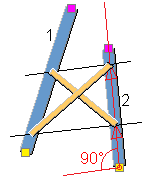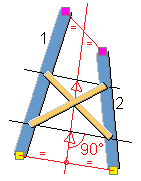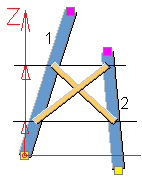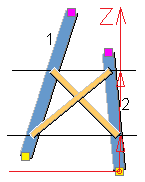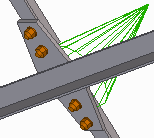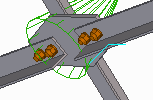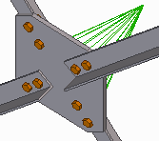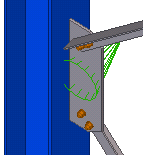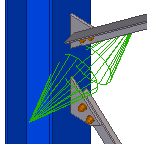Tensioner brace (13)
Tensioner brace (13) creates one or two bracing crosses between two columns or beams. It is also possible to add connections between columns or beams and the bracing crosses. You can define which connections are used.
Objects created
-
Bracing cross (1 or 2)
-
Connections between columns or beams and bracing crosses
-
Connections in bracing crosses
Use for
| Situation | Description |
|---|---|
|
|
One or two bracing crosses between two columns. |
To use Tensioner brace (13) you need to set the Up direction on the General tab to a fixed direction: -x,+x,-y,+y,-z, or +z.
The Auto option does not work.
Selection order
-
Select the first main part (column or beam).
-
Select the second main part (column or beam).
The connection is created automatically when the secondary part is selected.
Part identification key

| 1 | Diagonal bracing |
| 2 | Connection between the main part and the bracing |
| 3 | Connection in the bracing cross |
Picture tab
Use the Picture tab to control the bracing levels and bracing offsets.
Bracing levels

| Description | |
|---|---|
| 1 | Bottom level of the lower bracing cross. |
| 2 | Top level of the lower bracing cross. |
| 3 | Bottom level of the upper bracing cross. |
| 4 | Top level of the upper bracing cross. |
Bracing reference
For both main parts, define the reference side of the bracing levels. The reference side can be set for both in the horizontal and the vertical direction.
Example:

Bracing offset
Define the offset perpendicular to the bracing. You can move the created plate or part by entering a value in the x-, y, or z-direction.
Example:

Levels tab
Use the Levels tab to control the bracing direction when the columns are not parallel.
| Option | Description | ||
|---|---|---|---|
| Direction | Select the direction of the bracing. |
|
Start point of the main part as the reference point. |
|
|
End point of the main part as the reference point. | ||
| Calculation of levels | Select the reference line used for positioning the bracing when the main parts are not parallel. |
|
Offset from the start point in part 1, perpendicular to the line through the start points. |
|
|
Offset from the start point in part 1, in local x-direction. | ||
|
|
Offset from the start point in part 2, in local x-direction. | ||
|
|
Reference line through the start and end points of the main parts, offset from the start of the reference line. | ||
|
|
Offset from the start point in part 1, in z-direction. | ||
|
|
Offset from the start point in part 2, in z-direction. | ||
Parts tab
Use the Parts tab to control the properties, bracing position, and rotation. Additionally, you can define bracing splitting and shortening values.
| Option | Description | ||
|---|---|---|---|
| Windbracing | Define the bracing profile by selecting it from the profile catalog. | ||
| Windbracing rotation |
Select the rotation for the first and the second bracing element. This option is useful when the bracing elements are crossing and they are connected in the crossing. |
||
| Windbracing translation |
Select the offset of the first and the second bracing element from the reference points. This option is useful when the bracing elements are positioned so that the first bracing is alongside the second bracing. Typically, the first bracing element is set to Forwards and the second bracing element to Backwards. |
||
| Splitting the diagonal bracing |
Select whether the diagonal bracing elements are split or connected with a component. Define the connecting component on the Joints tab by typing the number of the component in the Connect diagonals with joint number box. |
Bracing is not split. Possible component for connecting the diagonal bracing: Seating (30). |
|
|
First diagonal bracing element is split. Possible component for connecting the diagonal bracing: Bolted gusset (11). |
|
||
|
Second diagonal bracing element is split. Possible component for connecting the diagonal bracing: Bolted gusset (11). |
|
||
|
Both diagonal bracing elements are split. Possible component for connecting the diagonal bracing: Central gusset (169). |
|
||
| Connecting bracing crosses |
Select whether the gusset plates of two bracing crosses above each other are connected. Define the connecting component on the Joints tab by typing the number of the component in the Connection number box. |
Bracing crosses are connected with a gusset connection. Possible component for connecting the diagonal bracing: Bolted gusset (11). |
|
|
Bracing crosses are not connected. Separate connection is created for each diagonal bracing. Possible component for connecting the diagonal bracing: Bolted gusset (11). |
|
||
| Distance between windbracings |
Define the distance between bracing elements. If the bracing elements are crossing each other, this value typically defines the gusset plate thickness. |
||
| Shorten windbracings |
Define how much the bracing are shortened. The entered value is written in the user-defined attributes of the bracing. The value is used in drawings. |
||
|
Option |
Description |
Default |
|---|---|---|
|
Pos_No |
Prefix and start number for the part position number. Some components have a second row of fields where you can enter the assembly position number. |
The default part start number is defined in the Components settings in . |
|
Material |
Material grade. |
The default material is defined in the Part material box in the Components settings in . |
|
Name |
Name that is shown in drawings and reports. |
|
|
Class |
Part class number. |
|
|
Comment |
Add a comment about the part. |
Joints tab
Use the Joints tab to define the components used for connecting the columns or beams and the bracing crosses.
| Option | Description |
|---|---|
| Creation of joints |
Select whether connections are created between the bracing elements. No: Only the bracing elements are created. Yes: Components are added between the bracing elements. |
|
Connection number Connect diagonals with joint number Userjoint application number Joint direction |
Type the component number that is used for
connecting the bracing or the diagonal bracing cross, and the
component application number. Select the connection direction
for the diagonal bracing cross.
|
|
Configuration file |
Configuration setting for the connection. For example, if you type CS_M13, it means that a setting named CS_M13 must be available for the used connection. |
|
Tensioner position |
Define the tensioner position if the Tensioner (7) connection is used. Example of Tensioner (7) position in both the Up and the Down position.
|
Joints dir tab
Use the Joints dir tab to control the up directions of the connections used between the main parts and the diagonal bracing.
In the example below, Seating (30) has been defined as the connecting component on the Joints tab:

General tab
Click the link below to find out more:
Analysis tab
Click the link below to find out more:




